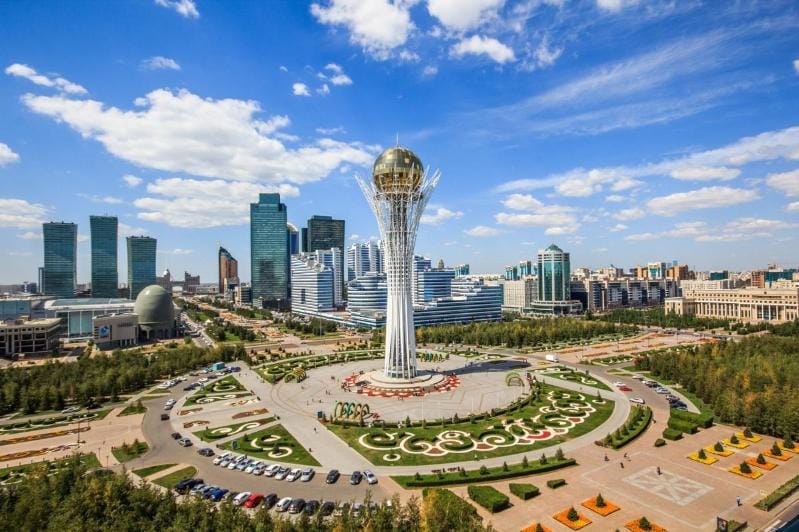Step into a world of wonder in Kazakhstan’s capital, Astana! A fascinating fusion of old and new, this thriving city is ready to sweep you off your feet. With its rich heritage and modern spirit, Astana offers a feast for your senses. Join us as we unravel the hidden gems of this enchanting metropolis, from breathtaking landmarks to a vibrant cultural scene. Prepare to be captivated by the charm and allure of Astana, a destination you won’t soon forget.
Capital of Kazakhstan: From Humble Beginnings to a City of the Future
Curious about the capital of Kazakhstan and what makes it so unique? Prepare to be amazed! This captivating city has experienced a remarkable transformation, complete with name changes, a metamorphosis from a modest town to a bustling metropolis, and its current status as a futuristic hub. It’s a story that mirrors Kazakhstan’s own journey as a nation, showcasing its aspirations and dreams for the future.
One of the capital’s most striking features is its awe-inspiring urban design. Imagine towering skyscrapers, unique buildings seemingly plucked from science fiction, and meticulous planning throughout. But it’s not just about aesthetics; sustainability is at the forefront, with eco-friendly initiatives and state-of-the-art infrastructure working in harmony.
Before the skyscrapers, the capital was a humble settlement known as Bozok. By 1830, it had emerged as Akmoly, and in 1997, it was officially designated as the capital we know today. These name changes reflect Kazakhstan’s captivating evolution over time.
Behind this architectural marvel is the visionary Kisho Kurokawa. This renowned architect seamlessly blended styles and pushed design boundaries, resulting in a breathtaking skyline that embodies Kazakhstan’s ambition and pursuit of innovation.
What truly sets the capital apart is its unwavering commitment to smart urban planning. Every detail, from inception, has been meticulously considered to create an efficient, livable, and future-proof city. Green initiatives are woven into the city’s fabric, demonstrating a dedication to both modernity and sustainability.
This vibrant city is a mesmerizing blend of history, innovation, and culture, where ancient traditions intertwine with modern aspirations. The result is an infectious energy that inspires all who visit.
Interested in exploring other capital cities? Check out our guides to the capitals of Canada, Madagascar, Albania, Cambodia, Norway, Bhutan, and Taiwan.
Apakah Astana dan Almaty Sama?
While both Astana and Almaty play significant roles in Kazakhstan, they offer distinct experiences. Think of them as siblings with unique personalities.
Astana, recently renamed Nur-Sultan and now back to Astana, embodies ambition and progress. This meticulously planned city, with its futuristic architecture, became Kazakhstan’s capital in 1997, reflecting the nation’s forward-thinking vision.
Almaty, the largest city in Kazakhstan, exudes a more relaxed, historical charm. While no longer the capital, it remains an economic powerhouse and a cultural gem. Imagine bustling markets, serene parks, and captivating mountain views.
Here’s a closer look:
| Feature | Astana (Nur-Sultan) | Almaty |
|---|---|---|
| Current Status | Capital City | Largest City |
| Known For | Modern architecture, government | Culture, economy, history |
| Atmosphere | Cosmopolitan, planned | Relaxed, historic |
Astana’s success as a planned city has inspired others, including Indonesia’s new capital, Nusantara, which considers it a potential blueprint for modern urban development.
Ongoing research on urban development suggests that both Astana and Almaty have captivating futures ahead. Their unique characteristics and roles continue to shape Kazakhstan’s urban landscape.
Apakah Nur Sultan dan Astana itu sama?
To clarify any confusion, Nur-Sultan and Astana refer to the same city, which has experienced several name changes throughout its history:
- Early Days (1830): Founded as Akmoly.
- Soviet Era (1961): Renamed Tselinograd.
- Independence (1992): Reverted to Akmoly.
- Becoming the Capital (1997): Renamed Astana, meaning “capital” in Kazakh.
- Honoring the President (2019): Changed to Nur-Sultan in tribute to former President Nursultan Nazarbayev.
- Back to Its Roots (2022): Reinstated as Astana.
Despite the name changes, Astana remains a captivating city. As the heart of Kazakhstan’s government, economy, and culture, it’s renowned for its modern, futuristic architecture, epitomized by the iconic Baiterek Tower and the unique Khan Shatyr Entertainment Center.
Apa yang dimaksud dengan Astana?
Astana, meaning “capital” in Kazakh, has undergone a fascinating evolution of names since its establishment in 1830. From Akmoly to Tselinograd during the Soviet period, back to Akmola after Kazakhstan’s independence, and finally to Astana in 1998, its name reflects its historical journey. The city was briefly renamed Nur-Sultan in 2019 to honor the first president, Nursultan Nazarbayev, but reverted to Astana in 2022.
Today, Astana is a pivotal city in Kazakhstan, serving as the country’s political, economic, and cultural hub. Important government institutions like the Parliament, Supreme Court, and Presidential Palace are located here. The city’s economy is thriving, driven by sectors like trade, industry, transportation, and construction.
Astana also shines on the international stage, hosting significant organizations like the UN and OSCE, making it a key location for global discussions and conflict resolution.
Architecturally, Astana is a sight to behold. Modern skyscrapers, futuristic buildings, and a well-planned layout contribute to its unique cityscape. Landmarks like the Baiterek Tower, Khan Shatyr Entertainment Center, and the National Museum of Kazakhstan showcase its architectural prowess.
In essence, Astana is:
- The “capital” in Kazakh.
- A city with a dynamic history, reflected in its name changes.
- The heart of Kazakhstan’s government, economy, and culture.
- A significant player in international diplomacy.
- Home to impressive, modern architecture.
Apakah astana ada di Rusia?
While Astana might share architectural similarities with some Russian cities, it is firmly rooted in Kazakhstan. Situated in the heart of Eurasia, a region where Europe and Asia intersect, Astana serves as a bridge between these continents, blending cultural influences and traditions.
Astana’s architecture is a captivating blend of the futuristic and traditional. Sleek, modern buildings stand alongside structures inspired by traditional Kazakh designs, creating a unique visual landscape. The Khan Shatyr Entertainment Center, designed by the renowned Norman Foster, resembles a massive transparent tent and houses an entire indoor city, complete with shops, restaurants, and a beach!
Beyond its modern marvels, Astana honors its nomadic past. The Bayterek Tower, a striking structure resembling a legendary poplar tree, symbolizes Kazakhstan’s growth and prosperity.
Astana, while not in Russia, embodies progress and innovation. It’s where East meets West and ancient traditions meet cutting-edge technology, showcasing Kazakhstan’s unique position in the world.
Mengapa orang pergi ke Almaty?
Almaty, often described as a hidden gem in Central Asia, draws visitors with its unique blend of natural beauty, rich culture, and adventurous spirit.
Imagine a vibrant city nestled amidst the towering, snow-capped Tien Shan mountains. The breathtaking scenery is a major draw for nature lovers and adventure seekers alike. From hiking and skiing to simply soaking in the fresh mountain air, Almaty offers an escape into nature’s embrace.
Beyond its natural wonders, Almaty boasts a rich history and culture. As the former capital of Kazakhstan, it has been a melting pot of influences, evident in its bustling traditional markets, fascinating museums, and delectable cuisine.
For thrill-seekers, Almaty offers world-class skiing at Shymbulak, white-water rafting in the mountain rivers, and horseback riding through picturesque landscapes. Those seeking a more relaxed experience can explore the city’s historic landmarks, such as the iconic Zenkov Cathedral, built entirely of wood without nails, or delve into Kazakhstan’s past at the Museum of Kazakhstan.
With its diverse offerings, from adrenaline-pumping adventures to cultural immersion and peaceful retreats, it’s no wonder Almaty leaves a lasting impression on visitors.
Kazakhstan mayoritas apa?
Islam is the most widely practiced religion in Kazakhstan, shaping the country’s cultural and historical landscape for centuries. According to the latest census data from 2021, approximately 70.2% of the population identifies as Muslim, with the majority adhering to the Sunni branch.
While Islam may be the majority religion, Kazakhstan embraces diversity. Christianity represents the second largest religious group, accounting for 26.6% of the population. Buddhism, Judaism, and Baha’i are also practiced, contributing to the country’s rich cultural tapestry.
Kazakhstan has a commendable history of religious tolerance. The government actively promotes interfaith dialogue and protects the religious freedom of its citizens, as enshrined in the Constitution. This commitment to tolerance is reflected in the diverse places of worship found throughout the country.
However, it’s important to acknowledge that challenges remain. Some religious groups have faced discrimination and persecution in the past. The Kazakh government is actively addressing these issues to ensure religious freedom for all.
Despite existing challenges, Kazakhstan stands as a beacon of religious diversity and tolerance in Central Asia. The government’s ongoing commitment to interfaith harmony ensures that the country’s rich cultural mosaic continues to thrive.
Di negara manakah Almaty berada?
Almaty is located in southeastern Kazakhstan, nestled at the foot of the Trans-Ili Alatau mountains. This vibrant city, a captivating blend of modernity and history, served as the capital of Kazakhstan until 1997, when the honor was passed to Nur-Sultan.
Despite no longer holding the title of capital, Almaty remains the largest city in Kazakhstan and a thriving center for culture and commerce. Its unique blend of Central Asian and Russian influences is evident in its delicious cuisine, colorful street art, and the welcoming nature of its people.
So, when you’re picturing a city brimming with culture, beauty, and a fascinating location, remember Almaty, Kazakhstan. Perhaps your next adventure will lead you to the heart of Central Asia to experience its wonders firsthand!
Astana di negara apa?
Astana, previously known as Nursultan, is the capital city of Kazakhstan. Located in the north-central part of the country, along the Ishim River, Astana is a planned city known for its futuristic architecture and modern infrastructure. Its name, meaning “capital” in Kazakh, was adopted in 1998 after a series of name changes influenced by its Soviet past, independence from Russia, and the legacy of former President Nursultan Nazarbayev.
Here’s a quick recap of Astana’s key attributes:
- Capital: Astana has served as the capital of Kazakhstan since 1997, replacing Almaty.
- Names: Astana, formerly Akmoly, Tselinograd, and Nursultan,
- Location: Central Kazakhstan, along the Ishim River.
- Significance: Center of government, economy, and culture, known for modern architecture and a population exceeding 1 million.
For a deeper dive into Astana’s history and significance, check out its Wikipedia page.
Apakah Almaty bagian dari Rusia?
While Almaty was once part of the Soviet Union, which included Russia, it is essential to remember that Kazakhstan declared its independence in 1991, becoming a sovereign nation. Therefore, Almaty is not part of Russia.
Today, Almaty thrives as the largest city in Kazakhstan, serving as a vital economic and cultural hub. The city attracts a diverse population of expats and tourists eager to experience the unique charm of Central Asia. A visit to Almaty offers a glimpse into the distinct culture and identity of Kazakhstan, separate from its Russian neighbor.
Here are the key takeaways:
- Almaty’s Status: The largest city in Kazakhstan, not a part of Russia.
- Kazakhstan’s History: Formerly part of the Soviet Union but gained independence in 1991.
- Almaty’s Allure: A captivating city with a rich cultural heritage and breathtaking natural beauty.
Mengapa Almaty bukan ibu kota Kazakstan?
While Almaty, with its rich history and captivating charm, served as Kazakhstan’s capital for many years, several factors contributed to the decision to move the capital to what is now Nur-Sultan (formerly Astana).
Geographic Constraints and Safety Concerns:
Almaty’s location, surrounded by mountains, limited its potential for expansion. The growing population needed more space, and the risk of earthquakes in this seismically active region raised concerns about the safety of a capital city. The government recognized the need for a capital that could accommodate growth and withstand potential natural disasters.
Strategic Location and Economic Considerations:
A more centrally located capital would ensure better accessibility and communication with all regions of Kazakhstan. Astana’s position in the north-central part of the country made it a more strategic choice. Additionally, moving the capital provided an opportunity to stimulate economic development in other areas, reducing the economic dependence on Almaty.
Key Takeaways:
- Limited Space: Almaty’s mountainous terrain restricted expansion possibilities.
- Seismic Risks: The region’s vulnerability to earthquakes posed a safety concern.
- Strategic Positioning: A central location was deemed more suitable for a capital.
- Economic Balance: The move aimed to promote more even economic development across Kazakhstan.
- Star Ring Trends: Etsy vs Amazon - March 28, 2025
- Boost Pollinator Habitats: Baby Blue Eyes Sustainable Farming Guide - March 28, 2025
- Protect Big Black Bears: Effective Conservation Strategies - March 28, 2025

















1 thought on “Unveiling the Charms of Astana: A Journey Through the Capital of Kazakhstan”
Comments are closed.